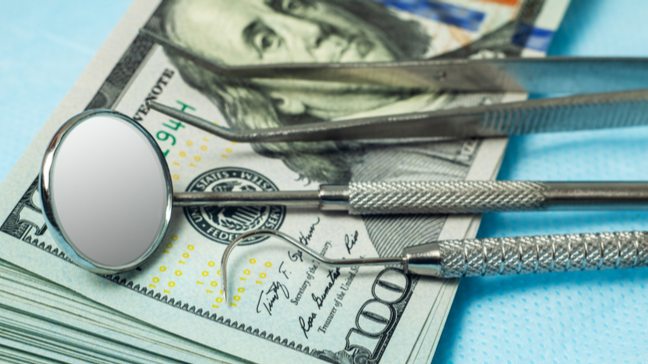Getting insurance seems like a no-brainer. Medical insurance, more often than not, saves you money in the short and long term. If your monthly premium is high, you’ll pay a lower deductible, and vice versa.
Dental insurance works a little differently.
There are pros and cons to purchasing a dental policy, either from your employer or from an insurance marketplace like Healthcare.gov. In some cases, dental coverage won’t save you money at all, even if you’re getting dental care.
How much does dental insurance cost?

On average, Americans pay about $360 a year, or between $15 and $50 a month, for dental insurance. Costs will vary depending on your state.
Most plans come with a maximum annual benefit or coverage limit. This limit usually falls between $1,000 and $2,000. Unlike medical insurance, which covers costs after your bills reach the amount of your deductible, dental insurance cuts off coverage after your bills reach the annual limit. You pay any additional costs out of pocket.
Only 2% to 4% of Americans will exhaust their maximum benefit annually, so you may not exceed your coverage limit. It’s more likely if you need a procedure like a root canal or a crown.
A typical plan provides a level of coverage known as 100/80/50 coverage.
- Preventive care – the exams, cleanings, and X-rays you receive during an average dental checkup – are 100% covered. Dentists recommend cleanings twice annually.
- Basic procedures like fillings, extractions, and periodontal work are 70% to 80% covered.
- Major procedures like crowns, root canals, dentures, bridges, or implants are 50% covered (or less).
There are variations in individual plans. For example, a root canal could be considered either a basic or a major procedure.
Most plans allow you to purchase separate coverage for orthodontic care if it isn’t covered. Fewer plans will cover cosmetic care (like teeth whitening). This is usually an out-of-pocket expense.
Dental plans emphasize preventive care, or care before anything goes wrong.
Preventive care may seem optional if you have healthy teeth and good oral hygiene, but it saves money in the long run. I went without dental insurance for three years in my twenties, and did what most of my peers did in that situation – simply didn’t visit the dentist. Then I enrolled in a graduate program which required students to have medical and dental coverage. At my first dental visit, I had numerous cavities. Getting them all filled required nine or ten appointments in the nine months of my academic year.
My plan covered cavity fillings, but an additional procedure (like a crown or an extraction) would have been costly even with insurance. Multiple appointments also took up a lot of time. I could have spared myself some of those cavities, and long hours in the dentist’s chair, if I’d got regular cleanings in earlier years (and, of course, flossed more often).
But would dental insurance have reduced the cost of bi-annual cleanings?
I could have paid the average of $360 a year for a dental policy in my twenties. Or I could have paid out of pocket for two dental exams, including cleanings and X-rays, which, in 2011, cost an average of $370 combined. In that case dental insurance wouldn’t have saved me much money. And if I went to a dental school or clinic for treatment, I could have saved even more on out-of-pocket costs.
Even if dental coverage doesn’t save you cash, it can be a good incentive to make those preventive-care appointments; you’re more likely to go to the dentist if you’ve already paid for the insurance. And a dollar spent on cleanings and X-rays can save $50 on a more time-consuming and pricey procedure in the future.
What types of dental insurance plans can you choose from?
The typical dental plan falls into one of three categories.
Indemnity or fee-for-service plans
This plan allows you to pick a dental provider and your plan pays a percentage of the provider’s fee.
Pros: These plans let you choose from the widest variety of providers. The deductible (the amount you pay for procedures before insurance coverage kicks in) may be lower than other plans. The annual maximum coverage limit may be higher.
Cons: The premiums (what you pay monthly) tend to be higher than other plans. You’ll be paying your share of service costs up front.
This plan is best if: You have a certain dental provider you want to see, or you anticipate needing major, costly procedures.
PPO or Preferred Provider Organization plans
With a PPO, you pay lower fees to see certain in-network or “preferred” providers.
Pros: The insurance network pays more than they might with an indemnity plan or HMO plan. You aren’t required to see in-network providers, but you save money when you do.
Cons: You’ll pay more if you see a provider out of the network. PPO plans often come with a maximum amount they’ll reimburse in a calendar year. Some procedures may not be covered or have a waiting period before coverage starts.
This plan is best if: You don’t need major dental work right away, but want to be prepared in case you need it in the future. You’d like some flexibility in your choice of dental providers but don’t want to pay high premiums.
HMO or Health Maintenance Organization plans
With an HMO, you’re required to see dental providers in the insurance network.
Pros: Preventive services — cleanings and X-rays —will be 100% covered, while basic procedures come with a co-pay. You may not have a deductible or maximum annual limit and premium payments will likely be lower.
Cons: Major or restorative procedures may come with less than 50% coverage or no coverage at all. You won’t have a large choice of providers.
This plan is best if: You don’t anticipate needing any major dental procedures in the near future. You have no provider preferences as long as basic dental work is covered financially.
If you already have a dental provider you trust, see which plan their office recommends.
Most plans won’t immediately cover pre-existing conditions or reimburse for major procedures completed before you got insurance. When in doubt, ask what’s covered and when.
Keep in mind there’s always a possibility you may need a procedure you don’t anticipate—and it may not be covered by your policy. The higher your premium, the more likely you are to have coverage for more extensive work. Your dentist will often tell you (or you can ask) which procedures you’re likely to need down the line.
What if you need extensive dental care (more than a cleaning or cavity filling)?

The bad news: with or without insurance, you’ll be shelling out some money. It’s a necessary evil. Teeth age, even with the most diligent brushing (my parents assure me a root canal is still far less expensive than my father’s dentures).
Remember those maximum annual limits? You can reach them quickly with even one major procedure. An average crown costs between $750 and $1,200.
A dental implant starts at $1,500, which is over the coverage limit for many plans. And while annual coverage caps remain about the same from year to year, the cost of dental services continues to rise.
If you plan to get insurance, your best bet is to purchase a policy before, not after, you need major work. Otherwise you could be waiting months for coverage to begin a procedure.
What if you’re uninsured and you already know you need major dental work soon?
See what your dentist recommends, but be prepared to have the procedure right away and pay out of pocket. Be honest about your financial situation and try to work out a payment plan. You’ll save more money than if you let the problem get worse while waiting for coverage to start.
What does dental care cost if you’re uninsured?
Like the price of insurance, the out-of-pocket price of dental care varies somewhat based on where you live. You’ll pay more in an area with a high cost of living.
The ADA Health Policy Institute’s 2013 Survey of Dental Fees (the latest publicly available data) compiled the average U.S. costs for some common procedures:
- Teeth cleaning: $85.
- Complete series of X-rays: $124.
- Silver dental filling: $125.
- White dental filling: $149.
- Porcelain crown: $1,000.
- Front tooth root canal: $762.
- Bicuspid (a tooth with two cusps) root canal: $879.
- Molar root canal: $1,111.
An important note – usually a root canal is followed by a crown, although the procedures are charged separately.
Average prices for root canals, compiled by FAIR Health, vary based on the tooth.
What questions should you ask before picking a policy?
- Which dental procedures am I likely to need this year?
- How much would they cost out of pocket?
- How much would they cost with insurance?
- How much will I pay monthly and annually in premiums?
- How much will I pay for a regular cleaning without insurance? With insurance?
What is the maximum annual payout for this insurance policy? Which procedures are covered?
How can you save money on dental care without insurance?
If you decide to skip dental insurance, you’ll still want to get your teeth cleaned once or twice a year. And you’ll want options if unexpected dental work comes up. Here’s where you can look for care outside of the typical insurance marketplace.
Visit a dental school
You’ll see students whose work is supervised by trained dentists. In exchange, you pay a low cost for appointments, even if you’re uninsured. The ADA lists dental schools across the country; find one near you.
Visit a dental clinic
Some clinics offer a sliding scale fee based on income, and diagnostic exams may be free. Find a local branch of a national clinic like America’s Dentists Care Foundation, or see what low-cost care options your state and local dental societies have to offer.
Dental school and clinic appointments are often in high demand. Be prepared to schedule far in advance or put your name on a waiting list. Even with walk-in clinics, it’s best to call ahead and find out their procedures before you go.
Look into a discount dental plan
Discount dental plans or dental savings plans can give you the security of coverage without the cost. You’ll pay an annual fee and get a discount, anywhere from 10% to 60%, on average dental care prices. Unlike insurance plans, there are no annual caps or waiting periods.
Policygenius has an analysis of dental discount plans, which (again, like insurance plans) require some comparison shopping for the best deal.
Self-insure
Maybe paying a monthly premium or fee isn’t worth the cost to you for a few appointments, but you still want some cash on hand for dental work if the need arises. Set aside a separate savings account for dental appointments and emergencies. Contribute at your own pace, and take care of your teeth in the meantime.
Summary
So is dental insurance worth it?
That depends on your dental health and the plan you choose. With more extensive procedures, having insurance can help cover the high cost, but chances are you’ll still be paying out of pocket for some of it.
The best thing dental insurance can offer is a safety net in case you end up needing these extensive procedures.